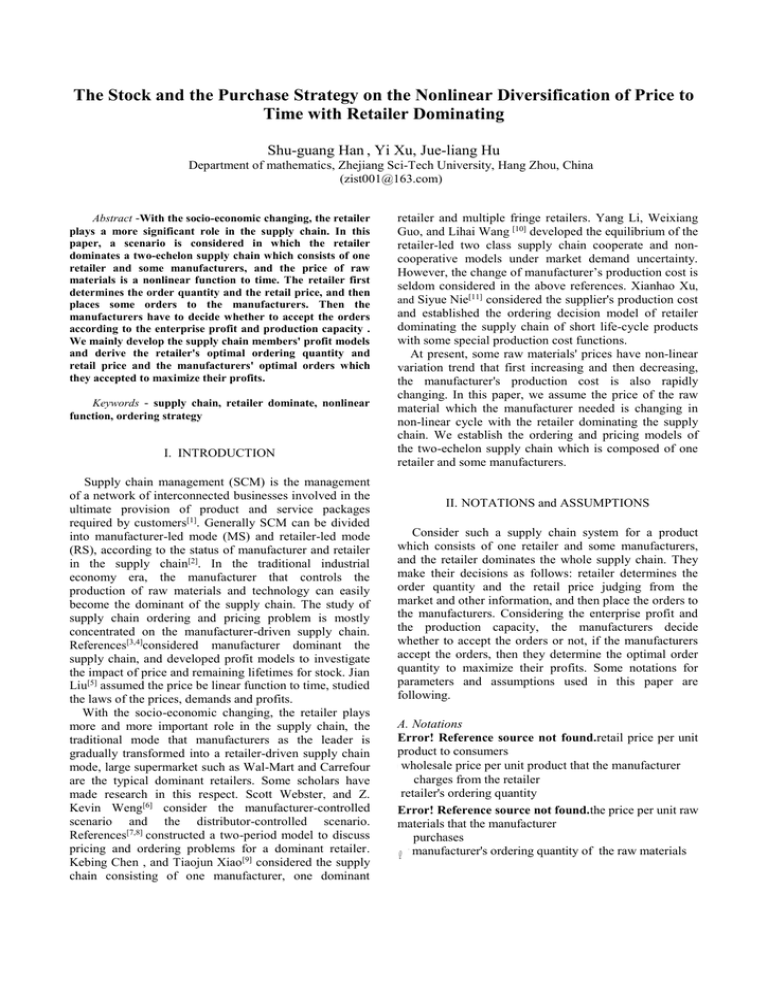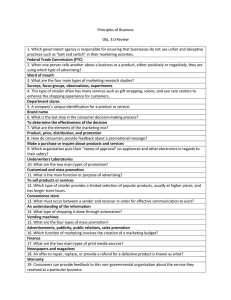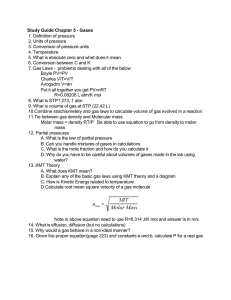The Stock and the Purchase Strategy on the Nonlinear Diversification... Time with Retailer Dominating
advertisement

The Stock and the Purchase Strategy on the Nonlinear Diversification of Price to Time with Retailer Dominating Shu-guang Han , Yi Xu, Jue-liang Hu Department of mathematics, Zhejiang Sci-Tech University, Hang Zhou, China (zist001@163.com) Abstract -With the socio-economic changing, the retailer plays a more significant role in the supply chain. In this paper, a scenario is considered in which the retailer dominates a two-echelon supply chain which consists of one retailer and some manufacturers, and the price of raw materials is a nonlinear function to time. The retailer first determines the order quantity and the retail price, and then places some orders to the manufacturers. Then the manufacturers have to decide whether to accept the orders according to the enterprise profit and production capacity . We mainly develop the supply chain members' profit models and derive the retailer's optimal ordering quantity and retail price and the manufacturers' optimal orders which they accepted to maximize their profits. Keywords - supply chain, retailer dominate, nonlinear function, ordering strategy I. INTRODUCTION Supply chain management (SCM) is the management of a network of interconnected businesses involved in the ultimate provision of product and service packages required by customers[1]. Generally SCM can be divided into manufacturer-led mode (MS) and retailer-led mode (RS), according to the status of manufacturer and retailer in the supply chain[2]. In the traditional industrial economy era, the manufacturer that controls the production of raw materials and technology can easily become the dominant of the supply chain. The study of supply chain ordering and pricing problem is mostly concentrated on the manufacturer-driven supply chain. References[3,4]considered manufacturer dominant the supply chain, and developed profit models to investigate the impact of price and remaining lifetimes for stock. Jian Liu[5] assumed the price be linear function to time, studied the laws of the prices, demands and profits. With the socio-economic changing, the retailer plays more and more important role in the supply chain, the traditional mode that manufacturers as the leader is gradually transformed into a retailer-driven supply chain mode, large supermarket such as Wal-Mart and Carrefour are the typical dominant retailers. Some scholars have made research in this respect. Scott Webster, and Z. Kevin Weng[6] consider the manufacturer-controlled scenario and the distributor-controlled scenario. References[7,8] constructed a two-period model to discuss pricing and ordering problems for a dominant retailer. Kebing Chen , and Tiaojun Xiao[9] considered the supply chain consisting of one manufacturer, one dominant retailer and multiple fringe retailers. Yang Li, Weixiang Guo, and Lihai Wang [10] developed the equilibrium of the retailer-led two class supply chain cooperate and noncooperative models under market demand uncertainty. However, the change of manufacturer’s production cost is seldom considered in the above references. Xianhao Xu, and Siyue Nie[11] considered the supplier's production cost and established the ordering decision model of retailer dominating the supply chain of short life-cycle products with some special production cost functions. At present, some raw materials' prices have non-linear variation trend that first increasing and then decreasing, the manufacturer's production cost is also rapidly changing. In this paper, we assume the price of the raw material which the manufacturer needed is changing in non-linear cycle with the retailer dominating the supply chain. We establish the ordering and pricing models of the two-echelon supply chain which is composed of one retailer and some manufacturers. II. NOTATIONS and ASSUMPTIONS Consider such a supply chain system for a product which consists of one retailer and some manufacturers, and the retailer dominates the whole supply chain. They make their decisions as follows: retailer determines the order quantity and the retail price judging from the market and other information, and then place the orders to the manufacturers. Considering the enterprise profit and the production capacity, the manufacturers decide whether to accept the orders or not, if the manufacturers accept the orders, then they determine the optimal order quantity to maximize their profits. Some notations for parameters and assumptions used in this paper are following. A. Notations Error! Reference source not found.retail price per unit product to consumers wholesale price per unit product that the manufacturer charges from the retailer retailer's ordering quantity Q Error! Reference source not found.the price per unit raw materials that the manufacturer purchases Q ' manufacturer's ordering quantity of the raw materials Error! Reference source not found. raw materials' amount of manufacturing unit product Error! Reference source not found. the time of manufacturing unit product Error! Reference source not found. the cost of manufacturing unit product except the purchase cost Error! Reference source not found. the time range of raw materials' price changing Error! Reference source not found. the unit cost of retailer's stock Error! Reference source not found. the profit of the manufacturer Error! Reference source not found. the optimal profit of the manufacturer Error! Reference source not found. the optimal ordering quantity that the manufacturer accepts Error! Reference source not found. the profit of the retailer Proposition 1. When t1 T 2 and t1 t2 T Q t2 t1 B. Assumptions 1) The retailer's revenue is composed of purchase cost and marginal profit, so the retailer can set retail price depending on the wholesale price and marginal price. We assume that:Error! Reference source not found. , where 01. 2) Demand with price dependence is assumed to follow the additive demand type[12]:Error! Reference source not found., where Error! Reference source not found.andError! Reference source not found.are respectively a constant intersection and slop of the price curve function. 3) Suppose the diurnal price of raw materials is related to the time and demand, the raw materials' price function to time is Error! Reference source not found. , where T 0 and c 0 . 2 let d M 0 , we get Q a (1 )(kt1 kTt1 n) . 0 2b 2ck 2 (1 ) dQ Discussing the value of Q* according to the signs of the second order derivative of M , that are III. MODEL BUILDING and SOLVING A. Manufacturer’s Optimal Decision The retailer determines the products' order quantity and the retail price, and then place orders to the manufacturers at time t1 . The manufacturers decide whether to accept such orders according to the enterprise profit and delivery date or not. If the manufacturers accepted the orders, then they are required to delivery products at time t2 . The manufacturers begin to product after receiving the orders and deliver once after finished, therefore the manufacturers' stock cost is not considered here. The manufacturer's total cost is the sum of the purchase cost and the production cost, thus the profit of the manufacturer is M Q Q' nQ . m m hold, the maximum profit of the manufacturer is b a * (ck 2 )Q*2 ( kt 2 kTt n)Q* . 1 1 Proof: When t1 T 2 , t2 t1 mQ and T 2 t1 t2 mQ T 2 hold, we can deduce t1 t2 T Q t2 t1 . The purchase m m M 1 1 cost of raw materials is the lowest, if purchasing raw materials Q ' at the time t1 , and they can deliver in time. Thus M Q Q ' nQ 1 (a bQ)Q (t12 Tt1 ckQ)kQ nQ 1 b a (ck 2 )Q 2 ( kt12 kTt1 n)Q 1 1 The maximum profit of the manufacturer is b a )Q*2 ( kt12 kTt1 n)Q* . 1 1 d M b a 2(ck 2 )Q kt12 kTt1 n dQ 1 1 M * (ck 2 So , and b b b 0 and ck 2 0 , ck 2 0 . 1 1 1 Lemma1. If ck 2 b 0 holds, then Q* Q . 1 Proof: When ck 2 b 0 and M ( a kt12 kTt1 n)Q , 1 1 ck 2 in order to make the model significant, let a kt12 kTt1 n 0 , the function of profit is monotone 1 increasing over the order quantity Q . Thus Q* Q and M * M (Q* ) . Lemma2. If ck 2 b 0 holds, then Q* Q . 1 Proof: When 2 b ck 2 0 , we can get d 2M 2(ck 2 b ) 0 . 1 dQ 1 Because of a kt12 kTt1 n 0 , the function of profit 1 is monotone increasing over the order quantity Q when Q 0 . Thus we can get Q* Q and M * M (Q* ) . Lemma3. When ck 2 b 0 , if t1 t2 T Q t2 t1 and 0 1 m m t t T t t Q Q0 hold, then Q* Q0 ; if 1 2 Q0 2 1 and m m Q Q0 hold, then Q* Q ; if Q0 t2 t1 , then Q* Q ; m if Q t1 t2 T , then Q* t1 t2 T . 0 m m Proof: When ck 2 b 0 1 , we can get d 2 M b 2(ck 2 ) 0 , M have the maximum dQ 2 1 value at the point Q0 , then we can deduce the lemma 3. Proposition2. When t1 T 2 and 0 Q t1 t2 T hold, m let d M 0 , we can get dQ Q1 b )Q*2 1 a ( kt2 2 kTt2 n)Q* 1 Proof: When , and t2 T 2 mQ t1 T 2 T 2 t1 t2 mQ T 2 hold, then 0 Q t1 t2 T . The m raw materials' purchase cost is the lowest, when purchasing raw materials Q ' at time t2 mQ , and they can deliver in time. Thus the manufacturer's profit is M Q Q ' nQ 1 (a bQ)Q [(t2 mQ) 2 T (t2 mQ) ckQ)]kQ nQ 1 b a km2Q3 (kmT ck 2 2kmt2 )Q 2 ( kt2 2 kTt2 n)Q 1 1 The maximum profit of the manufacturer is b )Q*2 1 a ( kt2 2 kTt2 n)Q* 1 d M b 3km 2Q 2 2(kmT ck 2 2kmt2 )Q . dQ 1 a kt2 2 kTt2 n 1 6km 2 4(kmT ck 2 2kmt2 Q3 0 kmT ck 2 2kmt2 b 1 2km 2 b 2 a ) 4km 2 ( kt2 2 kTt2 n) 1 1 2km 2 b kmT ck 2 2kmt2 1 Q5 2km 2 b 2 a (kmT ck 2 2kmt2 ) 4km 2 ( kt2 2 kTt2 n) 1 1 2km 2 (kmT ck 2 2kmt2 Lemma5. When b 2 a ) 3km 2 ( kt2 2 kTt2 n) 0 1 1 b hold, and also kmT ck 2 2kmt2 0 1 (kmT ck 2 2kmt2 and Next we discuss the value of Q for two cases: b 2 a (kmT ck 2kmt2 ) 3km 2 ( kt2 2 kTt2 n) 0 1 1 2 and b 2 a ) 3km 2 ( kt2 2 kTt2 n) 0 . 1 1 Lemma4. If (kmT ck 2 2kmt2 b 2 a ) 12km 2 ( kt2 2 kTt 2 n) 1 1 6km 2 Let M 0 , we can get * (kmT ck 2 2kmt2 b ) 1 b 2 a ) 12km 2 ( kt2 2 kTt 2 n) 1 1 6km 2 b 2(kmT ck 2 2kmt2 ) 1 Q2 2 6km Q4 M * km 2Q*3 ( kmT ck 2 2kmt 2 2(kmT ck 2 2kmt2 4(kmT ck 2 2kmt2 the maximum profit of the manufacturer is M * km 2Q*3 ( kmT ck 2 2kmt 2 b 2 a ) 3km 2 ( kt2 2 kTt2 n) 0 , 1 1 (kmT ck 2 2kmt2 b 2 a ) 3km 2 ( kt2 2 kTt2 n) 0 1 1 holds, then Q* Q . Proof: When * a kt2 2 kTt2 n 0 holds, we have Q Q . 1 Proof: When kmT ck 2 2kmt2 b 0 1 and a kt2 2 kTt2 n 0 , we can get Q1 0 , Q2 0 . Thus 1 when Q 0 , it has d M 0 , the function of profit is dQ monotone increasing over the order quantity t t T . In this case, we have Q* Q Q ,with 0 Q 1 2 m b 2 a (kmT ck 2 2kmt2 ) 3km 2 ( kt2 2 kTt2 n) 0 1 1 holds, we can obtain that d M 0 for any Q because and M * M (Q* ) . of 3km2 0 . So the function of profit is monotone increasing over the order quantity Q if 0 Q t1 t2 T . and kmT ck 2 2kmt b 0 , 2 1 a t t T * 2 , kt2 kTt2 n 0 if 1 2 Q1 , then Q Q ; if dQ m Thus we get Q* Q and When M * M (Q* ) . Lemma 6. When (kmT ck 2 2kmt2 b 2 a ) 3km 2 ( kt2 2 kTt2 n) 0 1 1 1 m t1 t2 T t1 t2 T , then Q* Q ; if and Q1 Q6 Q1 Q 1 m m t t T , then Q* Q , where t1 t2 T Q6 and Q6 Q 1 2 m m M (Q6 ) M (Q1 ) . From kmT ck 2 2kmt b 0 and 2 1 a 2 , we can get 0 Q1 Q4 Q2 Q5 . kt2 kTt2 n 0 1 If 0 Q Q1 or Q Q2 , the profit function is monotone Proof: increasing over the order quantity Q ; if Q1 Q Q2 , the function of profit is monotone decreasing over the order quantity Q . So we get the lemma 6. Lemma 7. When b 2 a (kmT ck 2kmt2 ) 3km 2 ( kt2 2 kTt2 n) 0 1 1 and a kt 2 kTt n 0 hold, if t1 t2 T Q , then the 2 2 5 m 1 2 manufacturer refuses the order; if t1 t2 T Q and 5 m t t T Q5 Q 1 2 m , then we have Q* Q . Proof: When a kt 2 kTt n 0 , we 2 2 1 get Q4 Q1 0 Q2 Q5 . Thus if 0 Q Q2 , it has d M 0 , dQ the function of profit is monotone increasing over the order quantity Q ; if Q Q2 , it has d M 0 , the function of dQ profit is monotone decreasing over the order quantity Q . When 0 Q Q5 , we can get M 0 because of M (0) 0 and M (Q5 ) 0 . So the manufacturer's profit less than zero. Therefore if t1 t2 T Q and 0 Q t1 t2 T , it has 5 m m M 0 , the manufacturer will refuse the order; if t1 t2 T and Q Q t1 t2 T Q5 5 m m , it has M 0 , the function of profit is monotone increasing over the order quantity Q . In this case, Q* Q and M * M (Q* ) hold, otherwise the manufacturer refuses the order. Proposition3. When t1 T 2 and 0 Q t2 t1 , the m maximum profit of the manufacturer is M * km 2Q*3 (kmT ck 2 2kmt2 b )Q*2 1 a ( kt2 2 kTt2 n)Q* 1 Proof: When t1 T 2 and t1 mQ t2 , which means 0 Q t2 t1 . The purchase cost of raw materials is m lowest, if purchasing raw materials Q ' at time t2 mQ , and they can deliver in the delivery period. Thus M Q Q ' nQ 1 (a bQ)Q [(t2 mQ) 2 T (t2 mQ) ckQ)kQ nQ 1 b a km2Q3 (kmT ck 2 2kmt2 )Q 2 ( kt2 2 kTt2 n)Q 1 1 The maximum profit of the manufacturer is M * km 2Q*3 (kmT ck 2 2kmt 2 b )Q*2 . 1 a ( kt2 2 kTt2 n)Q* 1 d M b 2 2 2 We get dQ 3km Q 2(kmT ck 2kmt2 1 )Q . a kt2 2 kTt2 n 1 Lemma8. When (kmT ck 2 2kmt2 b 2 a ) 3km 2 ( kt2 2 kTt2 n) 0 1 1 we have Q* Q . Lemma9. When b 2 a ) 3km 2 ( kt2 2 kTt2 n) 0 , 1 1 b a kmT ck 2 2kmt2 0 and kt2 2 kTt2 n 0 , 1 1 if 0 Q t2 t1 , then we get Q* Q , and otherwise m t2 t1 . * Q m (kmT ck 2 2kmt2 Lemma10. When b 2 a ) 3km 2 ( kt2 2 kTt2 n) 0 1 1 and kmT ck 2 2kmt b 0 , a kt 2 kTt n 0 , 2 2 2 1 1 (kmT ck 2 2kmt2 if t2 t1 Q , then m 1 Q* Q ; if Q t2 t1 Q and 1 6 m t2 t1 , then Q* Q ; if t2 t1 Q6 and Q1 Q 1 m m * t t Q6 Q 2 1 , then Q Q ,where M (Q6 ) M (Q1 ) ; if m Q t2 t1 , then * t2 t1 . Q m m Lemma11. When b 2 a ) 3km 2 ( kt2 2 kTt2 n) 0 1 1 and a kt 2 kTt n 0 , if t2 t1 Q , the manufacturer 2 2 5 1 m t t will refuse the order; if 2 1 Q and Q Q t2 t1 , 5 5 m m * t t t t * then Q Q ; if Q 2 1 , then Q 2 1 . m m (kmT ck 2 2kmt2 B. Retailer’s Optimal Decision The retailer determines the order quantity and the retail price according to the market and some other information. Suppose the daily market demand is a constant, so we can get the product stock of retailer using EOQ model. Proposition4. The maximum profit of the retailer is R b 2 a h Q ( )Q 1 1 2 Proof: The retailer's total cost is the sum of the purchase cost and the stock cost, thus the profit of the retailer is Q h Q Q 2 2 b 2 a h Q ( )Q 1 1 2 R pQ Q h Lemma12. The retailer's optimal ordering quantity 2a h h . a h h Q , optimal retail price p 2b 4 b 4b 4 Proof: It is easy to get d R 2 b Q a h . dQ 1 1 2 And let d R 0 , we get Q a h h . 2b 4 b 4b dQ 2 Because d R 0 , R have the maximum value at the 2 dQ point Q . At the moment the price is 2a h h . p a bQ 4 IV. CONCLUSION In this paper, we study the ordering and pricing problem of a two-echelon supply chain which consists of one retailer and some manufacturers with the retailer dominating the whole supply chain. We assume that the products' retail price is sensitive to the demand and the raw materials' price is related to time, and develop supply chain members' profit models. The differences of this paper from others are that the price of raw materials is a nonlinear function to time, and the order quantity and the wholesale price are determined by the retail in the supply chain system. However the models in this paper also have some limitations, such as the daily market demand is a constant. In the future research, we could extend the models that the product daily demand is changeable. ACKNOWLEDGMENT This research is supported by National Science Foundation under Grant No. 11071220 and Zhejiang Province Science Foundation under Grant No.Y6110091, Y6090554 and Y6090175. REFERENCES [1] C. M. Harland, "Supply chain management: relationships,chains and networks," British Journal of Management, vol.7, pp. 63-80, Mar.1996. [2] Steven, and M.Shugan, "Implicit understandings in channels of distribution", Management Science,vol.31, no.4, pp. 435 -460, Apr. 1985. [3] Z. Kevin Weng, "The power of coordinated decisions for short-life-cycle products in a manufacturing and distribution supply chain",IIE Transactions, vol.31, pp.1037-1049, 1999. [4] Eylem Tekin, Ulku Gurler, and Emre Berk, "Age-based vs. stock level control policy for a perishable invntory system", European Journal of Operational Research, vol.134, no.2, pp.309-329,Oct.2001. [5] Liu Jian, "The ordering and pricing strategy in the timevarying demand supply chain" (In Chinese), Industrial Technology & Economy, vol.23,no.1, pp.68-72,Feb.2004. [6] Scott Webster, and Z. Kevin Weng, "Ordering and pricing policies in a manufacturing and distribution supply chain for fashion products", International Journal of Production Economics, vol.114,no.2,pp.476-486,Aug.2008. [7] Kewen Pan, K.K.Lai, L.Liang, and StephenC.H.Leung. Two-period pricing and ordering policy for the dominant retailer in a two-echelon supply chain with demand uncertainty", Omega, vol.37, no.4, pp.919-929, Aug.2009. [8] Hua Zhongsheng, and Li Sijie, " Impacts of demand uncertainty on retailer’s dominance and manufacturerretailer supply chain cooperation", Omega, vol.36, no.5, pp.697-714, Oct.2008. [9] Kebing Chen , and Tiaojun Xiao, "Demand disruption and coordination of the supply chain with a dominant retailer", European Journal of Operational Research, vol.197, no.1, pp.225-234, Aug.2009. [10] Li Yang, GuoWeixiang, and Wang Lihai,"Game theory analysis on retailer-led two class supply chain under the condition of demand uncertainty" (In Chinese), Forest Engineering, vol.26, no.6, pp.82-84, Nov.2010. [11] Xu Xianhao, and Nie Siyue, "Game analysis of ordering strategy based on short life-cycle products in a retailer dominated supply chain" (In Chinese), Journal of Management Sciences, vol.12, no.4, pp.83-93, Aug.2009. [12] N.C. Peruzzi, and M. Dada, "Pricing and the newsvendor problem: a review with extensions", Operations Research, vol.47, no.2, pp.183-194,1999.





